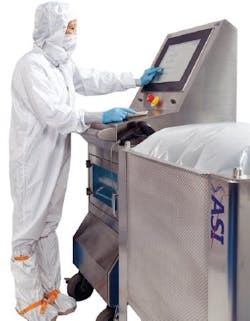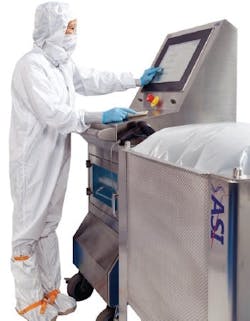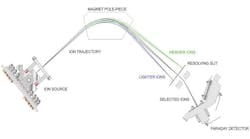Figure 1: Operators preparing a 3,000 L bag for a point-of-use integrity test.
There is little debate single-use systems have found a permanent place in bioproduction facilities. Once revolutionary, now commonplace, the acceptance and adoption of single-use technologies continues to grow. In addition, incorporating single-use technology in processes that are further and further downstream means that single-use bags are now closer to final product delivery, something that is changing how the industry views quality testing for single-use systems.FOCUS ON DOWNSTREAM QUALITY
In upstream processes, most of the liquids are media or buffer solutions, which are of comparatively lower value and recoverable by sterile filtration in the event of a problem. However, for downstream process equipment, and for containers used to store product further downstream, quality concerns magnify. Downstream protein purification (where the protein is isolated and purified) is one of the final steps in biopharmaceutical manufacturing. With such high value relative to the rest of the process, and no way to recover or decontaminate materials as there is upstream, sterility and leak detection of single-use bags becomes a QSM-oriented operational imperative.
To a great extent, concerns involving bag integrity issues associated with poor manufacturing quality control are a thing of the past. Single-use technology manufacturers, including ASI, have instituted well defined and documented quality procedures that assure performance and reliability. As a result, bag quality and integrity inspection routines as well as operator handling have now become more of a focus, particularly for single-use systems used in downstream production.
CARE IN HANDLING AND OTHER ISSUES
Even when single-use bags’ integrity is verified and in perfect shape coming off the delivery truck, there are multiple opportunities for flaws to be introduced between the truck and installation on the process floor. Flaws can be introduced by such things as improper loading of the bag into the equipment, connecting tubes and hoses, or simple inadvertent mishandling that goes unnoticed. Handling errors can cause microscopic tears or worse, and the further downstream this occurs in the process the more it can impact final product quality.
GET AS CLOSE AS YOU CAN
Figure 2: Operators initializing a validated fine leak test.
Most operational staff understands the best time to test single-use bags is just prior to use, when the bags are in place and ready to use. Called point-of-use testing, the procedure is usually part of a thorough QSM regime to detecting flaws that in practice can be introduced through handling errors or installation mistakes. This type of test can lower the risk of lost time, loss of product, and even improve operator safety.Point-of-use testing systems can mitigate the risk of flaws being introduced and unnoticed during operations such as shipping, unloading and installation. Such testing systems give manufacturers the ability to test every bag and produce reports that document the testing procedure and results.
Flaws from a bag already installed in the tank, mixer or bioreactor can happen a few ways. A large, obvious leak, usually called a “gross leak” can occur from an unattached hose. There are many tubing elements that require connection during media prep, bioreactor setup, or transfer of inoculum or other transfers. On the other hand, a fine leak test needs to be able to spot a flaw so tiny that it could elude the naked eye. Both types of leaks threaten production time and supply, and pose significant financial risk for the manufacturer. In addition, in the case of vaccine production, leaks can pose a threat to operator safety.
INTEGRITY TESTING METHODS VARY
There are two integrity testing methods on the market today: helium integrity testing and pressure decay testing.
Helium integrity testing takes the entire bag assembly and places it inside a sealed chamber, evacuates the air and introduces a measured quantity of helium into the bag. The vacuum pulled inside the chamber ensures that helium will escape through holes in the bag, and a mass spectrometer is then used to detect and quantify the helium.
Pressure decay testing is a tried-and-true industry standard [ASTM F2095-01] for testing flexible bags. The term “pressure decay testing” refers to a change of pressure inside a pressurized containment during a leak test. The test is an inflation test in which the bag is pressurized to a preset level. After the bag system has been stabilized, the decay in pressure over time is evaluated to determine if a leak is present. If the pressure is lost, then air has escaped from inside the bag, and a drop in pressure correlates to the size of the defect.
The advantage of pressure decay testing is that it ensures that no alternative gasses are introduced into the cleanroom, by using in-room air, and can detect leakage problems with a high degree of accuracy. Innovations in the flexibility and mobility of such technology have occurred recently, where mobile units are available that can be wheeled to the exact container for testing.
DOCUMENTATION AND FLEXIBILITY KEY
Pressure Decay Detection tests should quickly be able to locate small leaks (between 100 microns and 1,000 microns) and confirm connection and setup of the bag system; fine leak detection tests will uniquely validate each tank and bag assembly. Very fine leak detection is possible and is dependent on the environment and the time allotted for the testing to occur.
The initial pressure decay approach should always include the purposeful comparison of intentionally flawed bags and non-flawed bags during the validation set-up procedure. A comparison of these tests measures the changes in pressure that occur.
According to ASI, its inSITE system has some special and useful characteristics. The system, explains ASI, walks users through a validation set-up, which then becomes unique to each bag and tank combination and is stored in memory for later access. A wireless PC Operating system allows the user to save, store and email testing results. Recorded results are available as PDFs, and files can be emailed, printed and saved for future use. These documents become part of the audit trail that accompanies the product being manufactured, a feature that is highly valued by the manufacturers.
ASI says its system inflates to a specified pressure allowing the user to load the bag more easily. For gross leak detection, users simply select the gross leak test to find large defects and visible leaks. A gross leak detection test will also indicate a loose tube or nozzle. Fine leak selection is similar. Users can select the fine leak test to detect pinholes, small tears and leaks. Lastly, inSITE testing can be applied to bags of virtually any tank size, although the current maximum size is 3,000 Liters.
A consistent environment is required for each setup and test because any variance in these conditions can affect the test results. The test is a pressure test which makes it ultra-sensitive to changes in external pressure, tank size and room temperature.
Another aspect to ask about when looking for pressure-decay integrity systems for point-of-use is automatic inflation, which can assist operators in loading bags with minimal human intervention, reducing operator handling errors that can cause tears in the first place.
A liquid filling monitor is also available, which moderates internal pressure within the bag for the purpose of monitoring over-fill. It works by regulating the open/close position of the coaxial valve.
Single-use technology in biopharmaceutical production continues to grow, and its move into downstream processing has pushed the focus on quality testing of the technology in the same direction: downstream. In many ways, it is heartening to see the partnerships taking place between manufacturer and single-use suppliers to improve usability, flexibility and accuracy of integrity testing. As the application of single-use technology continues to move from upstream to downstream, the focus of testing will move in parallel, and has put a spotlight on doing everything possible to ensure and document quality in products that are so much closer to final production batch. Pressure decay testing is up to the challenge.








